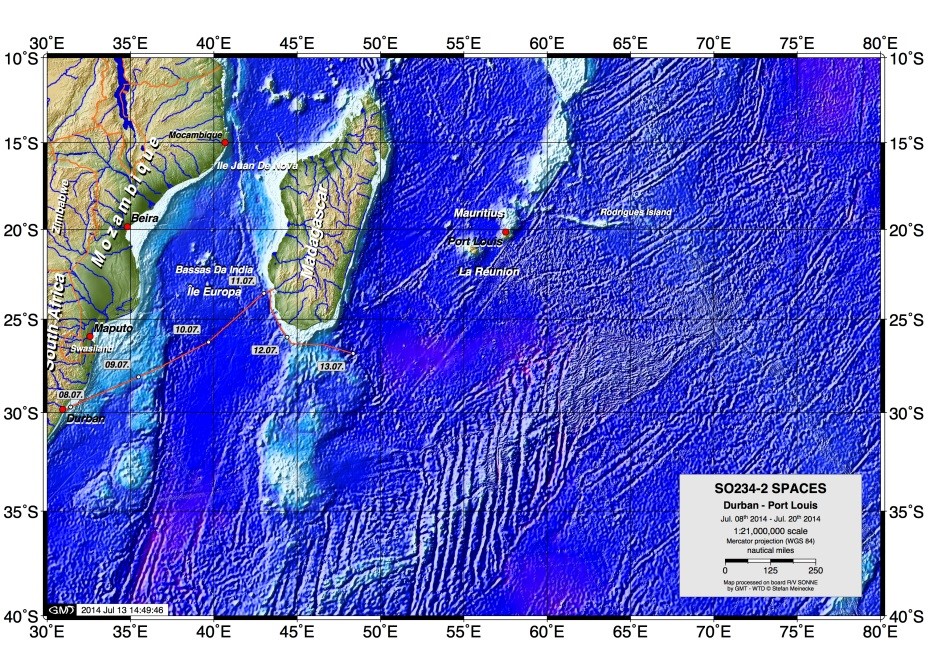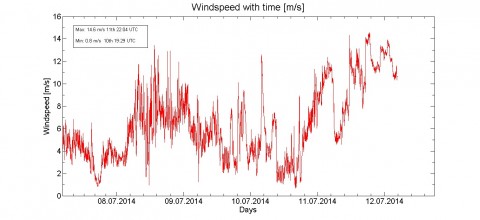08.07-13.07.2014 (Durban/South Africa – 27° S, 24° E)
Here is the first Weekly Report from our SPACES (Science Partnerships for the Assessment of Complex Earth System Processes) SONNE SO234-2 cruise, a training and capacity building cruise for students from southern Africa and Germany. Fifteen students from South Africa, Namibia and Germany are participating, along with 9 scientists and an observer from Madagascar. The goal of our training and research cruise concerns the air-sea gas exchange between the atmosphere and the ocean, and the transport of ocean trace gases from the Indian Ocean to the stratosphere during the southwest Monsoon. This research project is funded within the national BMBF program SPACES.
On 08.07.2014 at 11:40 local time instrument installation was performed, and the majority of 51 instruments were operational at the time of departure. With stormy southerly winds and up to 4 meter waves, a northerly course was set towards the Mozambique Channel. The “old” SONNE started to roll. Thanks to the help of the ship doctor Dr. Sabine Heuser, only a few passengers became sea sick. On the afternoon of 08.07.2014 the first lecture was given. In the evening, an “ice-breaker” was held for students and crew to meet each other, indoors in the “Kegelbahn” on account of the weather conditions. The training and exchange program had begun. Given our proximity to the South African coast, we were luckily able to follow the first 5 goals of the Germany vs. Brazil World Cup game on live television. The later three goals were not visible through the “snow” on the TV, but were heard through the audio feed. The motto of the Germany team – “One for all, all for one” should serve as an example for the SO234-2 cruise.
On the second day at sea, the regular training program of the SPACES SO234-2 began, with daily lectures from 8:30-11:30 and afternoon practical sessions from 13:30-17:00 at the more than 50 instruments on our Sonne expedition. (Soccer results: Argentina vs Netherlands, 4:2 decided by penalty kicks, the competitors for the final are decided).
Preliminary highlights of the measurements:
We find ourselves in strong southeasterly winds, the so-called trade winds, with temperatures just above 20° C. We have performed three deep-water profiles and launched approximately 18 radiosondes, measuring the ocean down to 4400 m and the upper atmosphere up to almost 30 km. Thereby the structure and content of the deep ocean and the marine to middle atmosphere can be investigated in more detail, which will be an important milestone for the transport modelling of atmospheric gases. For the investigation of climate and ozone relevant gases we have 7 GC/GC-MS (Gas Chromotography/Mass Spectrometers) on board, much more than in comparison to our previous Sonne cruises TransBrom and SHIVA. With these very complex instruments, we will measure halogens and sulphuric substances in the ocean and in the marine atmosphere, in order to estimate the gas exchange. For many of these natural gases, for example Bromoform (CHBr3) and Dibromomethane (CH2Br2), these measurements are the first of their kind in the Indian Ocean.
On account of a medical emergency with a crewmember, on Friday 11.07.2014 we adjusted our course for a short stop in the harbor of Tuléar in southwest Madagascar. After a short stop of 5 hours we continued with a well-cared and relieved crew member. On account of this incident, we had to adjust our cruise track, with a route around the southern tip of Madagascar. As such we passed around the coast of Madagascar under strong easterly winds. A potential scientific highlight will be the region of the Banc Banc l’Etoile, a coral reef with strong biological productivity. Preliminary analysis of the in-situ GC-MS measurements in this area show the highest water and air concentrations and trace gas emissions since the start of the cruise. We are very excited about the detailed results we will obtain back at our home laboratories, when we can investigate the biological and chemical sources, water and air concentrations and marine emissions.
Between the 10th and 12th of July three cruise participants had birthdays, and together invited us all to an international birthday party – for details of the student’s impressions see Oceanblogs (www.oceanblogs.org/sonne-oasis). This evening we will celebrate the half-way point of the cruise with the traditional “Bergfest” with the scientific participants and ship crew together. As a bonus, tonight is the World Cup final, Germany vs. Argentina, and we will be watching closely by live ticker.
Until one week’s time, with more news from SO234-2.
Your Cruise leader Kirstin Krüger (University of Oslo, Norway) and your SPACES/OASIS project leaders Christa Marandino and Birgit Quack (GEOMAR Kiel, Germany).

